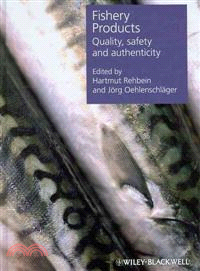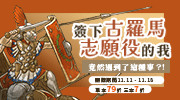Fishery Products - Quality, Safety And Authenticity
商品資訊
ISBN13:9781405141628
出版社:John Wiley & Sons Inc
作者:Rehbein
出版日:2009/05/08
裝訂/頁數:精裝/496頁
規格:25.4cm*17.8cm*3.2cm (高/寬/厚)
定價
:NT$ 11702 元優惠價
:90 折 10532 元
若需訂購本書,請電洽客服 02-25006600[分機130、131]。
商品簡介
作者簡介
名人/編輯推薦
目次
相關商品
商品簡介
Food quality and safety issues continue to dominate the press, with most food companies spending large amounts of money to ensure that the food quality and assessment procedures in place are adequate and produce good and safe food. This holds true for companies and laboratories responsible for the processing of fish into various products, those responsible for researching safe new products, and departments within other companies supporting these functions.
Fishery Products brings together details of all the major methodologies used to assess the quality of fishery products in the widest sense. Subject coverage of this important book includes chapters on assessment of authenticity, and several chapters on quality assessment using various methods, such as:
Texture measurement
Electronic nose and tongue
NMR
Colour measurement
This timely volume will serve as a vital tool for all those working in the processing of fishery and aquaculture products: including laboratory personnel working in regulatory bodies, food quality control personnel, food scientists, food technologists, nutritionists, seafood trade bodies, seafood labelling regulatory bodies, government food protection agencies and environmental health personnel. Libraries in research establishments and universities where food science, food technology, nutrition, aquaculture, fisheries and biological sciences are studied and taught should have copies of this important publication on their shelves.
Fishery Products brings together details of all the major methodologies used to assess the quality of fishery products in the widest sense. Subject coverage of this important book includes chapters on assessment of authenticity, and several chapters on quality assessment using various methods, such as:
Texture measurement
Electronic nose and tongue
NMR
Colour measurement
This timely volume will serve as a vital tool for all those working in the processing of fishery and aquaculture products: including laboratory personnel working in regulatory bodies, food quality control personnel, food scientists, food technologists, nutritionists, seafood trade bodies, seafood labelling regulatory bodies, government food protection agencies and environmental health personnel. Libraries in research establishments and universities where food science, food technology, nutrition, aquaculture, fisheries and biological sciences are studied and taught should have copies of this important publication on their shelves.
作者簡介
Dr Hartmut Rehbein and Prof. Dr Jörg Oehlenschläger both of Max Rubner-Institut, Federal Research Institute for Nutrition and Food, Department of Safety and Quality of Milk and Fish Products, Germany
名人/編輯推薦
"Emphasize[s] applied methodologies rather than analytical methods, and discuss[es] traditional, microbiological, sensory, and authenticity methods, among others, and multivariate data analysis and traceability." (Book News, December 2009)
目次
List of contributors
Preface
Introduction
Chapter 1 Basic facts and figures (Jörg Oehlenschläger and Hartmut Rehbein).
1.1 Introduction
1.2 World fishery production
1.3 Categories of fish species
1.4 Fish muscle
1.5 Nutritional composition
1.6 Vitamins
1.7 Minerals
1.8 Post mortem changes in fish muscle
1.9 References and further reading
Chapter 2 Traditional methods (Peter Howgate).
2.1 Introduction
2.2 TVB-N
2.3 Methylamines
2.4 Volatile acids
2.5 Volatile reducing substances
2.6 Indole
2.7 Proteolysis and amino acids
2.8 pH
2.9 Refractive index of eye fluids
2.10 Discussion and summary
2.11 References
Chapter 3 Biogenic amines (Rogério Mendes).
3.1 Introduction
3.2 Factors affecting amine decarboxylase activity
3.3 Safety aspects
3.4 Quality assessment
3.5 Regulatory issues
3.6 Methods of biogenic amine determination
3.7 References
Chapter 4 ATP-derived products and K-value determination (Margarita Tejada).
4.1 In vivo role of nucleotides
4.2 Post mortem changes
4.3 Methodology for evaluating the K-value or related compounds
4.4 Conclusions
4.5 References
Chapter 5 VIS/NIR spectroscopy (Heidi Anita Nilsen and Karsten Heia).
5.1 Introduction
5.2 Analytical principles and measurements
5.3 Constituents: assessment of chemical composition
5.4 Freshness and storage time
5.5 Authentication
5.6 Safety
5.7 Other quality parameters
5.8 Summary and future perspectives
5.9 References
Chapter 6 Electronic nose and electronic tongue (Corrado Di Natale and Gudrun Ólafsdóttir).
6.1 Introduction to the electronic nose and olfaction
6.2 Application of the electronic nose and electronic tongue
6.3 Colorimetric techniques, optical equipment and consumer electronics
6.4 Classification of fish odours
6.5 Quality indicators in fish during chilled storage: gas chromatography analysis of volatile compounds
6.6 Application of the electronic nose for evaluation of fish freshness
6.7 Combined electronic noses for estimating fish freshness
6.8 Conclusions and future outlook
6.9 References
Chapter 7 Colour measurement (Reinhard Schubring).
7.1 Introduction
7.2 Instrumentation
7.3 Novel methods of colour evaluation
7.4 Colour measurement on fish and fishery products
7.5 Summary
7.6 References
Chapter 8 Differential scanning calorimetry (Reinhard Schubring).
8.1 Introduction
8.2 Principle of function of the instruments
8.3 First applications of DSC on fish muscle and other seafood
8.4 Recent applications of DSC for investigating quality and safety
8.5 Summary
8.6 References
Chapter 9 Instrumental texture measurement (Mercedes Careche and Marta Barroso).
9.1 Introduction
9.2 Instrumental texture
9.3 Texture measurement for quality classification or prediction
9.4 Conclusions
9.5 References
Chapter 10 Image processing (Michael Kroeger).
10.1 Introduction
10.2 Quality characteristics from images
10.3 Spectral signature of images
10.4 Elastic properties from images
10.5 Analysis of image data
10.6 Results and discussion
10.7 Freshness determination from images
10.8 Firmness information from images
10.9 Conclusions
10.10 References
Chapter 11 Nuclear magnetic resonance (Marit Aursand, Emil Veliyulin, Inger B. Standal, Eva Falch, Ida G. Aursand and Ulf Erikson).
11.1 Introduction
11.2 Magnetic resonance imaging
11.3 Low-field NMR
11.4 High-resolution NMR
11.5 The future of NMR in seafood
11.6 References
Chapter 12 Time domain spectroscopy (Michael Kent and Frank Daschner).
12.1 Introduction
12.2 Measurement system
12.3 Time domain reflectometry measurements
12.4 Conclusions
12.5 References
Chapter 13 Measuring electrical properties (Michael Kent and Jörg Oehlenschläger).
13.1 Introduction
13.2 Fischtester
13.3 Torrymeter
13.4 Use of the Fischtester
13.5 Summary
13.6 References
Chapter 14 Two-dimensional gel electrophoresis (Flemming Jessen).
14.1 Introduction
14.2 Two-dimensional gel electrophoresis (2DE)
14.3 2DE applications in seafood science
14.4 2DE-based seafood science in the future
14.5 References
Chapter 15 Microbiological methods (Ulrike Lyhs).
15.1 Microorganisms in fish and fish products
15.2 General aspects of microbiological methods
15.3 Most probable number method
15.4 Molecular methods
15.5 References
Chapter 16 Protein-based methods (Hartmut Rehbein).
16.1 Introduction
16.2 Fish muscle proteins
16.3 Electrophoretic methods for fish species identification
16.4 High-performance liquid chromatography
16.5 Immunological methods and detection of allergenic proteins
16.6 Determination of heating temperature
16.7 Differentiation of fresh and frozen/thawed fish fillets
16.8 References
Chapter 17 DNA-based methods (Hartmut Rehbein).
17.1 Introduction
17.2 DNA in fishery products
17.3 Genes used for species identification
17.4 Methods
17.5 Conclusions and outlook
17.6 References
Chapter 18 Other principles: analysis of lipids, stable isotopes and trace elements (Iciar Martinez).
18.1 Introduction
18.2 Species and breeding stock identification by lipid analysis
18.3 Verification of the production method
18.4 Identification of the geographic origin
18.5 Future prospects
18.6 References
Chapter 19 Sensory evaluation of seafood: general principles and guidelines (Emilia Martinsdóttir, Rian Schelvis, Grethe Hyldig and Kolbrun Sveinsdóttir).
19.1 General principles for sensory analysis
19.2 Application of sensory evaluation to fish and other seafood
19.3 References
Chapter 20 Sensory evaluation of seafood: methods (Emilia Martinsdóttir, Rian Schelvis, Grethe Hyldig and Kolbrun Sveinsdóttir).
20.1 Introduction
20.2 Difference tests
20.3 Grading schemes
20.4 Quality index method
20.5 Descriptive sensory analysis
20.6 Consumer tests (hedonic)
20.7 References
Chapter 21 Data handling by multivariate data analysis (Bo M. Jørgensen).
21.1 Introduction
21.2 What is multivariate data analysis?
21.3 Arrangement of data for bi-linear modelling
21.4 The outcome of bi-linear modelling
21.5 Validation and prediction
21.6 Real examples and further reading
21.7 References
Chapter 22 Traceability as a tool (Erling P. Larsen and Begoña Pérez Villarreal).
22.1 Introduction
22.2 Traceability from older times to the present
22.3 Traceability research in the seafood sector and other EU-funded food traceability projects
22.4 Validation of traceability data
22.5 Traceability in a global perspective
22.6 References
Index
Preface
Introduction
Chapter 1 Basic facts and figures (Jörg Oehlenschläger and Hartmut Rehbein).
1.1 Introduction
1.2 World fishery production
1.3 Categories of fish species
1.4 Fish muscle
1.5 Nutritional composition
1.6 Vitamins
1.7 Minerals
1.8 Post mortem changes in fish muscle
1.9 References and further reading
Chapter 2 Traditional methods (Peter Howgate).
2.1 Introduction
2.2 TVB-N
2.3 Methylamines
2.4 Volatile acids
2.5 Volatile reducing substances
2.6 Indole
2.7 Proteolysis and amino acids
2.8 pH
2.9 Refractive index of eye fluids
2.10 Discussion and summary
2.11 References
Chapter 3 Biogenic amines (Rogério Mendes).
3.1 Introduction
3.2 Factors affecting amine decarboxylase activity
3.3 Safety aspects
3.4 Quality assessment
3.5 Regulatory issues
3.6 Methods of biogenic amine determination
3.7 References
Chapter 4 ATP-derived products and K-value determination (Margarita Tejada).
4.1 In vivo role of nucleotides
4.2 Post mortem changes
4.3 Methodology for evaluating the K-value or related compounds
4.4 Conclusions
4.5 References
Chapter 5 VIS/NIR spectroscopy (Heidi Anita Nilsen and Karsten Heia).
5.1 Introduction
5.2 Analytical principles and measurements
5.3 Constituents: assessment of chemical composition
5.4 Freshness and storage time
5.5 Authentication
5.6 Safety
5.7 Other quality parameters
5.8 Summary and future perspectives
5.9 References
Chapter 6 Electronic nose and electronic tongue (Corrado Di Natale and Gudrun Ólafsdóttir).
6.1 Introduction to the electronic nose and olfaction
6.2 Application of the electronic nose and electronic tongue
6.3 Colorimetric techniques, optical equipment and consumer electronics
6.4 Classification of fish odours
6.5 Quality indicators in fish during chilled storage: gas chromatography analysis of volatile compounds
6.6 Application of the electronic nose for evaluation of fish freshness
6.7 Combined electronic noses for estimating fish freshness
6.8 Conclusions and future outlook
6.9 References
Chapter 7 Colour measurement (Reinhard Schubring).
7.1 Introduction
7.2 Instrumentation
7.3 Novel methods of colour evaluation
7.4 Colour measurement on fish and fishery products
7.5 Summary
7.6 References
Chapter 8 Differential scanning calorimetry (Reinhard Schubring).
8.1 Introduction
8.2 Principle of function of the instruments
8.3 First applications of DSC on fish muscle and other seafood
8.4 Recent applications of DSC for investigating quality and safety
8.5 Summary
8.6 References
Chapter 9 Instrumental texture measurement (Mercedes Careche and Marta Barroso).
9.1 Introduction
9.2 Instrumental texture
9.3 Texture measurement for quality classification or prediction
9.4 Conclusions
9.5 References
Chapter 10 Image processing (Michael Kroeger).
10.1 Introduction
10.2 Quality characteristics from images
10.3 Spectral signature of images
10.4 Elastic properties from images
10.5 Analysis of image data
10.6 Results and discussion
10.7 Freshness determination from images
10.8 Firmness information from images
10.9 Conclusions
10.10 References
Chapter 11 Nuclear magnetic resonance (Marit Aursand, Emil Veliyulin, Inger B. Standal, Eva Falch, Ida G. Aursand and Ulf Erikson).
11.1 Introduction
11.2 Magnetic resonance imaging
11.3 Low-field NMR
11.4 High-resolution NMR
11.5 The future of NMR in seafood
11.6 References
Chapter 12 Time domain spectroscopy (Michael Kent and Frank Daschner).
12.1 Introduction
12.2 Measurement system
12.3 Time domain reflectometry measurements
12.4 Conclusions
12.5 References
Chapter 13 Measuring electrical properties (Michael Kent and Jörg Oehlenschläger).
13.1 Introduction
13.2 Fischtester
13.3 Torrymeter
13.4 Use of the Fischtester
13.5 Summary
13.6 References
Chapter 14 Two-dimensional gel electrophoresis (Flemming Jessen).
14.1 Introduction
14.2 Two-dimensional gel electrophoresis (2DE)
14.3 2DE applications in seafood science
14.4 2DE-based seafood science in the future
14.5 References
Chapter 15 Microbiological methods (Ulrike Lyhs).
15.1 Microorganisms in fish and fish products
15.2 General aspects of microbiological methods
15.3 Most probable number method
15.4 Molecular methods
15.5 References
Chapter 16 Protein-based methods (Hartmut Rehbein).
16.1 Introduction
16.2 Fish muscle proteins
16.3 Electrophoretic methods for fish species identification
16.4 High-performance liquid chromatography
16.5 Immunological methods and detection of allergenic proteins
16.6 Determination of heating temperature
16.7 Differentiation of fresh and frozen/thawed fish fillets
16.8 References
Chapter 17 DNA-based methods (Hartmut Rehbein).
17.1 Introduction
17.2 DNA in fishery products
17.3 Genes used for species identification
17.4 Methods
17.5 Conclusions and outlook
17.6 References
Chapter 18 Other principles: analysis of lipids, stable isotopes and trace elements (Iciar Martinez).
18.1 Introduction
18.2 Species and breeding stock identification by lipid analysis
18.3 Verification of the production method
18.4 Identification of the geographic origin
18.5 Future prospects
18.6 References
Chapter 19 Sensory evaluation of seafood: general principles and guidelines (Emilia Martinsdóttir, Rian Schelvis, Grethe Hyldig and Kolbrun Sveinsdóttir).
19.1 General principles for sensory analysis
19.2 Application of sensory evaluation to fish and other seafood
19.3 References
Chapter 20 Sensory evaluation of seafood: methods (Emilia Martinsdóttir, Rian Schelvis, Grethe Hyldig and Kolbrun Sveinsdóttir).
20.1 Introduction
20.2 Difference tests
20.3 Grading schemes
20.4 Quality index method
20.5 Descriptive sensory analysis
20.6 Consumer tests (hedonic)
20.7 References
Chapter 21 Data handling by multivariate data analysis (Bo M. Jørgensen).
21.1 Introduction
21.2 What is multivariate data analysis?
21.3 Arrangement of data for bi-linear modelling
21.4 The outcome of bi-linear modelling
21.5 Validation and prediction
21.6 Real examples and further reading
21.7 References
Chapter 22 Traceability as a tool (Erling P. Larsen and Begoña Pérez Villarreal).
22.1 Introduction
22.2 Traceability from older times to the present
22.3 Traceability research in the seafood sector and other EU-funded food traceability projects
22.4 Validation of traceability data
22.5 Traceability in a global perspective
22.6 References
Index
主題書展
更多
主題書展
更多書展今日66折
您曾經瀏覽過的商品
購物須知
外文書商品之書封,為出版社提供之樣本。實際出貨商品,以出版社所提供之現有版本為主。部份書籍,因出版社供應狀況特殊,匯率將依實際狀況做調整。
無庫存之商品,在您完成訂單程序之後,將以空運的方式為你下單調貨。為了縮短等待的時間,建議您將外文書與其他商品分開下單,以獲得最快的取貨速度,平均調貨時間為1~2個月。
為了保護您的權益,「三民網路書店」提供會員七日商品鑑賞期(收到商品為起始日)。
若要辦理退貨,請在商品鑑賞期內寄回,且商品必須是全新狀態與完整包裝(商品、附件、發票、隨貨贈品等)否則恕不接受退貨。
























